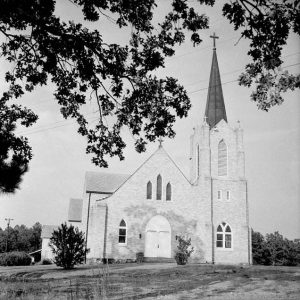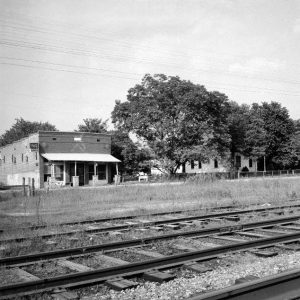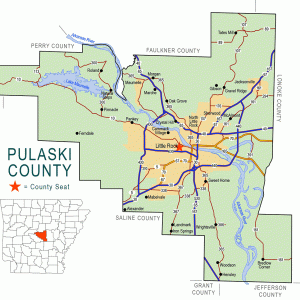calsfoundation@cals.org
Marche (Pulaski County)
Marche, a community located in Pulaski County twelve miles north of Little Rock (Pulaski County), was settled by Polish immigrants wishing to escape the struggles of life in the northern United States. The settlement of Marche is one of the most successful efforts to resettle immigrants in Arkansas history.
In 1872, Judge Liberty Bartlett attempted to establish a town in the area now known as Marche. The town of Bartlett never took hold, and the Little Rock and Fort Smith Railroad gained control of the area and renamed it Warren Station. The railroad company attempted to turn Warren Station into a recreation center for the people of Little Rock. By 1877, however, this project had failed, and the railroad land was put up for sale. This 11,000 acres, which ran west along the railroad from about ten miles northwest of Little Rock toward the Pulaski-Faulkner county line, was then bought by a Polish count in order to provide farms for Polish immigrants, who later named this site Marche, French for “marketplace.”
While in Wisconsin, Count Timothy von Choinski, a nobleman and political refuge from Poland, became concerned with the suffering of many of his fellow Polish immigrants who were residing in the slums of large cities such as New York and Chicago. Choinski wished to improve the working and living condition of these immigrants and began the search for a farming environment that was more familiar to these Poles. While reading a Polish-language newspaper, Choinski was introduced to suitable farmland in central Arkansas. After meeting with the land agent for the Little Rock and Fort Smith Railway in March 1877, Choinski purchased 22,000 acres ten miles northwest of Little Rock.
In May 1877, twenty-two fellow Poles visited the site with Choinski and agreed to settle on half of the purchase. Several different groups of Poles began to settle in the area that summer. A fraction of these immigrants returned to the North after they discovered that the land was not cleared and houses were not built. Eighty-five families remained after this initial wave of settlement.
In the fall of 1878, Father Anthony Jaworski arrived at Marche. Jaworski was the first of a series of Holy Ghost Fathers to serve the spiritual needs of the community. Upon Jaworski’s arrival, a small wooden chapel, named the Immaculate Heart of Mary Church, was built high on a hill. This hill was named “Jasna Gora,” or “Sky-Blue Mountain,” after a famous shrine in Poland. A larger building replaced the original church in 1896 and served the community until it was destroyed by fire in 1932. Its replacement was dedicated in May 1933.
During World War II, one of six ordnance plants was established nearby, and the federal government expanded Camp Pike, renaming it Camp Robinson. This expansion required that about forty families in Marche relocate to the city, where government jobs awaited them. Despite the expansion of Camp Robinson, Marche continued to develop. In 1960, a new school replaced an earlier schoolhouse, built in 1924. The Immaculate Heart of Mary Church’s Life Center was completed in 1999 for parish community activities. This church continues to celebrate Karnawal to increase the awareness of the community’s Polish heritage.
For additional information:
Besancon-Alford, Julia G. “The History of Marche, Arkansas.” Pulaski County Historical Review 41 (Winter 1993): 78–90.
Historical Commission of the Diocese of Little Rock. The History of Catholicity in Arkansas, from the Earliest Missionaries Down to the Present Time. Little Rock: The Guardian, 1925.
Immaculate Heart of Mary Catholic Church and School. https://www.ihmnlr.org (accessed August 26, 2023).
Marche, Arkansas, Community History Collection (BC.MSS.23.17). Butler Center for Arkansas Studies. Central Arkansas Library System, Little Rock, Arkansas. https://arstudies.contentdm.oclc.org/digital/search/searchterm/mss.23.17 (accessed January 18, 2024).
Sarna, Jan. “Marche, Arkansas: A Personal Reminiscence of Life and Customs.” Arkansas Historical Quarterly 36 (Spring 1977): 31–49.
Woods, James. Mission and Memory: A History of the Catholic Church in Arkansas. Little Rock: August House, 1993.
Jamie Metrailer
University of Arkansas at Little Rock
 Marche Catholic Church
Marche Catholic Church  Marche Store
Marche Store  Pulaski County Map
Pulaski County Map 




My grandfather Thomas Kromraj and my grandmother Mary Zawislak Kromraj were born in the 1890s in Marche. I’m looking for information on Ignatz Kromraj, Thomas’s father. He died young in his 20s and is buried in Marche.